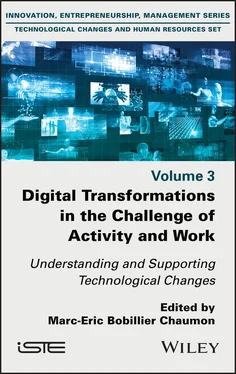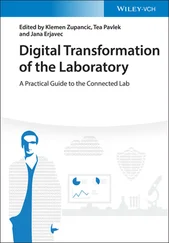Digital Transformations in the Challenge of Activity and Work
Здесь есть возможность читать онлайн «Digital Transformations in the Challenge of Activity and Work» — ознакомительный отрывок электронной книги совершенно бесплатно, а после прочтения отрывка купить полную версию. В некоторых случаях можно слушать аудио, скачать через торрент в формате fb2 и присутствует краткое содержание. Жанр: unrecognised, на английском языке. Описание произведения, (предисловие) а так же отзывы посетителей доступны на портале библиотеки ЛибКат.
- Название:Digital Transformations in the Challenge of Activity and Work
- Автор:
- Жанр:
- Год:неизвестен
- ISBN:нет данных
- Рейтинг книги:4 / 5. Голосов: 1
-
Избранное:Добавить в избранное
- Отзывы:
-
Ваша оценка:
- 80
- 1
- 2
- 3
- 4
- 5
Digital Transformations in the Challenge of Activity and Work: краткое содержание, описание и аннотация
Предлагаем к чтению аннотацию, описание, краткое содержание или предисловие (зависит от того, что написал сам автор книги «Digital Transformations in the Challenge of Activity and Work»). Если вы не нашли необходимую информацию о книге — напишите в комментариях, мы постараемся отыскать её.
Digital Transformations in the Challenge of Activity and Work — читать онлайн ознакомительный отрывок
Ниже представлен текст книги, разбитый по страницам. Система сохранения места последней прочитанной страницы, позволяет с удобством читать онлайн бесплатно книгу «Digital Transformations in the Challenge of Activity and Work», без необходимости каждый раз заново искать на чём Вы остановились. Поставьте закладку, и сможете в любой момент перейти на страницу, на которой закончили чтение.
Интервал:
Закладка:
The goal of this chapter is to question the place and impact that these emerging technologies can have in the often paradoxical transformations and development of activity. The first step will be to identify and characterize the emerging technologies that are being deployed in companies. Then, we will discuss the impact they may have on professionals and their activity.
1.2. From properties to the uses of emerging technologies
Disruptive digital innovation manifests itself through a variety of technologies that are being deployed in a number of business sectors. Thus, collaborative robots (cobots, exoskeletons), communicating, ambient or ubiquitous technologies (Internet of Things), artificial intelligence (voice assistants, decision support systems), evaluative and predictive data exploitation (Big Data), immersive environments (virtual and/or augmented reality) and new modalities of human–machine interaction (haptics, sensory, cognitive technologies of BIM (brain interface machine) type – brain interface machine) find applications in various fields of our professional and socio-domestic life. They can be found with the factory of the future, the hospital of the future, the smart home, autonomous transport, connected health (HCS/home care service, HS/home support; Martineau and Bobillier Chaumon 2017) or in the services offered by digital work platforms (uberization, robotics; Casilli 2019).
In order to understand the impact of technologies on professional activity and to identify research and societal issues that are addressed to the scientific community, it is necessary beforehand to clarify what they cover in terms of uses and practices, as well as what they bring in terms of resources and constraints.
1) Collaborative robots (also called cobots) are assistants, which remain dependent on the intention, gesture or behavior of humans at work. They support the employee in his/her actions and adjust their interventions to those of the professional. It is no longer simply a robotic substitute or a form of mechanical assistance for particular tasks. Here, robotics becomes symbiotic (Brangier et al . 2009), that is, it extends (like an extension) the individual by enabling the increase of human capacities in terms of strength, speed or precision. In this new context of interaction where these mobile and learning systems evolve, new forms of cooperation and human–robot interfaces (HRIs) are to be imagined and deployed. The exoskeleton constitutes a special class of cobots. It is a device for electrically, pneumatically or hydraulically amplifying the movement of each segment of the body. This kind of external skeleton allows movements, load handling and tool management that the body alone would not be able to perform (Claverie et al . 2013). The return of sensation is then immediate, and we witness a certain form of global person–machine consciousness, a hybrid body schema, or what Merle (2012) calls “the illusion of uniqueness”. However, we must be careful, because these exoskeletons that are grafted onto the human body strongly constrain body movements and gestures. It is more about adjusting to this “mechanical corset” than the other way around: the actions of the body can be repressed or even prevented, with possible impacts on the physical health of employees (increase in musculoskeletal disorders – MSDs).
2) Ambient, ubiquitous or pervasive technologies constitute a second class of these emerging innovations, more generally known as the “Internet of Things” (IoT) or connected/communicating objects. These discrete (because they are non-intrusive) technologies are integrated into everyday objects (Nehmer et al. 2006). They seek to capture activity and trigger the appropriate actions, without the need for human intervention (Gossardt 2017) (e.g. the thermostat that communicates with the personal calendar to turn on the heating at the appropriate time). These can be sensors scattered throughout the living or working space to record physical activities (quantified-self; Zouinar 2019), to inform the individual and thus fight against sedentariness: people are then made aware of what they are doing, what they are not doing – well or not well enough – and what they should do better (concept of “technological persuasion”, nudge technology or captology; Fogg 2002). There are also digital tracers integrated into production lines to evaluate, in real time, the conformity of professional actions to expected standards. Maintenance is no longer merely corrective, it becomes predictive. That is, we are able to react before the error is made by measuring the nut and bolt too, if it is wrong or not tight enough. This is the idea of the connected factory of the future (Factory 4.0).
3) Artificial intelligence (AI) is highly sophisticated algorithmic programs based on artificial neural networks. They aim to solve specific problems for which human beings use their cognitive abilities (Zouinar 2020). What constitutes the strength of these devices is their “reasoning” power, which is based on deep learning or machine learning (see Chapter 6). These particular machine learning techniques make it possible to analyze, extract and classify large amounts of data. These programs are used to make diagnoses (skin cancer detection is more reliable than human expertise), make decisions (90% of stock market orders are now made by AI systems, such as high-frequency trading) or “naturally” assist humans in their daily activities, for example, Google’s voice assistant, capable of making appointments by phone, voice-recognition systems (connected speakerphone) or chat-bot systems that automatically answer customers’ questions on websites. These devices are “artificial intelligence” because they are capable of some form of learning, or even “intuition” to deal with complex and sometimes unprogrammed situations. This is the case of the autonomous car, which has to manage a wide range of unforeseen events and incidents on its course. However, it should also be recalled that although AI is capable of learning, evolving and taking initiatives 1, it is incapable of giving meaning to what it sees or does or to the information it processes. Concretely, it can recognize the presence of a cat in millions of photos, but it does not know what a cat is. Symbolic processing and cognitive flexibility remain for the moment the prerogative of humans.
4) In order to function, AI must be able to access large volumes of data provided by, among others, Big Data. Big Data refers to the ability to produce or collect digital data, store, analyze and visualize them (Cardon 2015). The traces we leave on the Internet (“likes”, comments), the data sent by connected objects… on all aspects and at all times of our lives constitute a considerable mass of information 2on how we act, think and even on what we experience and feel (Dagiral et al . 2019). However, this raw data have little meaning and value as it stands. The challenge is to assign value to them through correlation, in order to transform them into information, and then into knowledge about the subject, that is relevant, useful and focused data. These are “smart data”. Combined with predictive models, these systems are capable of evaluating and anticipating individual behavior in some detail, or even seek to modify attitudes and decisions (as in the case of the Cambridge Analytica scandal 3).
5) Immersive environments (based on virtual, augmented and tangible reality) consist of immersing a person in an artificial environment, by stimulating their sensory (via sound, vision, smell), cognitive (information and decision-making) and sensory-motor (haptics, gestures) modalities via appropriate digital devices (3D headsets, haptic gloves, etc.) (see Chapter 3). This world can be imaginary, symbolic or simulate certain aspects of the real world. Different types of immersive environments can be distinguished:
Читать дальшеИнтервал:
Закладка:
Похожие книги на «Digital Transformations in the Challenge of Activity and Work»
Представляем Вашему вниманию похожие книги на «Digital Transformations in the Challenge of Activity and Work» списком для выбора. Мы отобрали схожую по названию и смыслу литературу в надежде предоставить читателям больше вариантов отыскать новые, интересные, ещё непрочитанные произведения.
Обсуждение, отзывы о книге «Digital Transformations in the Challenge of Activity and Work» и просто собственные мнения читателей. Оставьте ваши комментарии, напишите, что Вы думаете о произведении, его смысле или главных героях. Укажите что конкретно понравилось, а что нет, и почему Вы так считаете.












